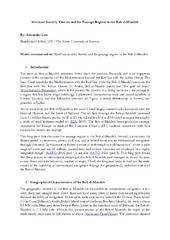Maritime Security Threats and the Passage Regime in the Bab el-Mandeb
Permanent lenke
https://hdl.handle.net/10037/21765Dato
2021-06-21Type
Journal articleTidsskriftartikkel
Peer reviewed
Forfatter
Lott, AlexanderSammendrag
The strait of Bab el-Mandeb separates Africa from the Arabian Peninsula and is an important element in the connection of the Mediterranean Sea and the Red Sea with the Indian Ocean. The Suez Canal interlinks the Mediterranean with the Red Sea, while the Bab el-Mandeb connects the Red Sea with the Indian Ocean. In Arabic, Bāb al-Mandab stands for “the gate of tears” (Encyclopaedia Britannica), which in the present-day context is a fitting name for a sea passage in a region that has borne tragic sufferings: a protracted humanitarian crisis and armed conflicts in Yemen, Somalia, and the Ethiopian province of Tigray, a brutal dictatorship in Eritrea, and genocide in Sudan. At the same time, the Bab el-Mandeb is the world’s third-largest maritime oil chokepoint after the Strait of Hormuz and the Strait of Malacca. The oil flow through the Bab el-Mandeb increased from 5.1 million barrels per day (b/d) in 2014 to 6.2 million b/d in 2018 which accounts for roughly a tenth of total seaborne-traded oil (EIA, 2019). The Bab el-Mandeb bears particular strategic importance for Europe as most of the European Union’s (EU) maritime commerce with Asia crosses this narrow sea passage.
Beskrivelse
Published version available at: https://site.uit.no/nclos/2021/06/21/maritime-security-threats-and-the-passage-regime-in-the-bab-el-mandeb/
Forlag
Norwegian Centre for the Law of the SeaSitering
Alexander Lott, “Maritime security threats and the passage regime in the Bab el-Mandeb” ( June 21, 2021), online The NCLOS Blog: https://site.uit.no/nclos/2021/06/21/maritime-security-threats-and-the-passage-regime-in-the-bab-el-mandeb/Metadata
Vis full innførselSamlinger
Copyright 2021 The Author(s)


 English
English norsk
norsk